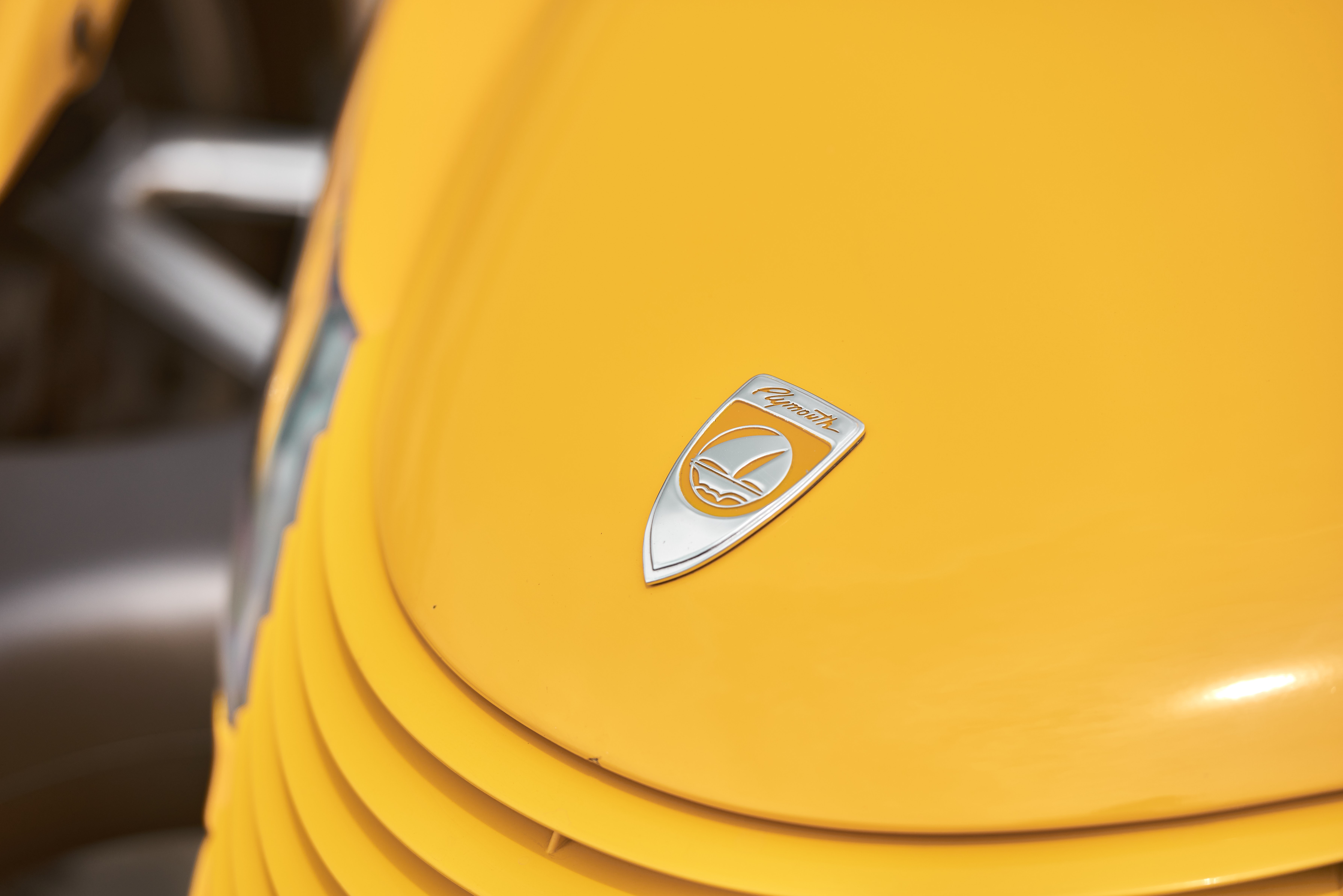Chrysler, fresh off the success of the Viper, decided to give its design and engineering teams free rein to create something truly unique. The result was the Plymouth Prowler, a vehicle that embodied the spirit of 1930s American hot rods but reimagined for the modern era of the 1990s. This bold move was spearheaded by Chrysler’s design director, Thomas C. Gale, a passionate enthusiast of classic hot rods, who envisioned a contemporary interpretation of these automotive icons.
The Prowler’s design genesis is often linked to Gale’s own hot-rodded 1932 Ford, which served as a key source of inspiration. However, it was the renowned hot rod specialist Chip Foose who ultimately refined and finalized the Prowler’s distinctive and captivating aesthetic. Foose’s expertise in hot rod design ensured the Prowler captured the essence of the classic style while incorporating modern design sensibilities.
Image alt text: Front three quarter view of a purple Plymouth Prowler parked on an asphalt road, showcasing its open wheel design and distinctive grille.
In the 1990s, the American automotive industry, and Chrysler in particular, was facing significant challenges. Many of Chrysler’s offerings at the time, including models like the Neon, Intrepid, 300M, Sebring, and Caravan (with the possible exception of the Caravan minivan), struggled to compete effectively against their Japanese and European counterparts. More crucially, these vehicles lacked the excitement and desirability that could inject new life into the brand.
Chrysler envisioned the Plymouth Prowler as a game-changer, a vehicle designed to shatter perceptions and demonstrate the company’s ability to create truly exciting and desirable automobiles once again. The Prowler was intended to be a statement car, proving to the world that Chrysler still possessed the creative spark and engineering prowess to produce vehicles that could capture the imagination of car enthusiasts.
Image alt text: Side profile of a yellow Plymouth Prowler highlighting its long hood, rear-set cockpit, and low-slung roadster silhouette.
However, the financial realities of Chrysler at the time imposed significant constraints on the Prowler project. To ensure its production viability, the Prowler had to be developed in a cost-effective manner, necessitating the use of existing Chrysler components wherever possible. This pragmatic approach, while essential for bringing the Prowler to market, ultimately led to some compromises in its performance.
The most notable compromise was under the hood. Despite its aggressive hot rod styling that suggested a powerful V8 engine, the Plymouth Prowler was equipped with a 3.5-liter V6 engine. This engine, shared with Chrysler’s more mainstream sedans, delivered a rather underwhelming 214 horsepower and 221 lb-ft of torque in its initial iteration. Adding to the disappointment was the transmission: a four-speed “Autostick” automatic gearbox borrowed from the Eagle Vision, further diminishing the Prowler’s sporty aspirations. The absence of a manual transmission option was a significant point of criticism for driving enthusiasts who felt it was a missed opportunity to enhance the Prowler’s driver engagement.

Image alt text: Close-up view of the Plymouth Prowler’s front grille and fender, emphasizing its retro styling cues and painted details.
Despite these limitations, Chrysler engineers worked diligently to imbue the Prowler with some semblance of sports car handling and driving dynamics. One notable engineering effort was the adaptation of the front-wheel-drive transmission for rear-wheel-drive configuration. The transmission was relocated to the rear of the vehicle and connected to the engine via a torque tube, a design element reminiscent of the C5 Corvette, aimed at improving weight distribution and handling.
Furthermore, the Plymouth Prowler made extensive use of aluminum in its construction to minimize weight. This focus on lightweighting resulted in a vehicle that weighed approximately 2,800 pounds, making it lighter than contemporary sports cars like the Porsche 911 and Acura NSX. This lighter weight contributed positively to the Prowler’s agility and responsiveness, partially offsetting the engine’s power deficit.
Image alt text: Interior view of a Plymouth Prowler showing the dashboard, steering wheel, and seats, highlighting the retro-modern design theme.
The Plymouth Prowler underwent a facelift in 1999, which brought with it some welcomed improvements. The most significant upgrade was a more potent version of the 3.5-liter V6 engine, now producing a more respectable 253 horsepower and 255 lb-ft of torque. This power increase provided a noticeable improvement in performance, allowing the updated Prowler to achieve a 0-60 mph acceleration time of around six seconds. This enhanced engine remained in place until the Prowler’s production ended in 2002.
Image alt text: Rear view of a Plymouth Prowler showcasing its sloping rear deck, prominent fenders, and dual exhaust outlets, emphasizing its hot rod inspired rear styling.
In conclusion, the Plymouth Prowler stands as a testament to Chrysler’s ambition to inject excitement and bold design into its lineup during a challenging period. While the Prowler’s performance capabilities were ultimately constrained by budgetary realities and component sharing, its striking retro hot rod design and unique character cemented its place as a memorable and distinctive vehicle. The Prowler served its purpose as a halo car, demonstrating Chrysler’s design creativity, even if it left some enthusiasts wanting more in terms of raw power and a more engaging driving experience.
